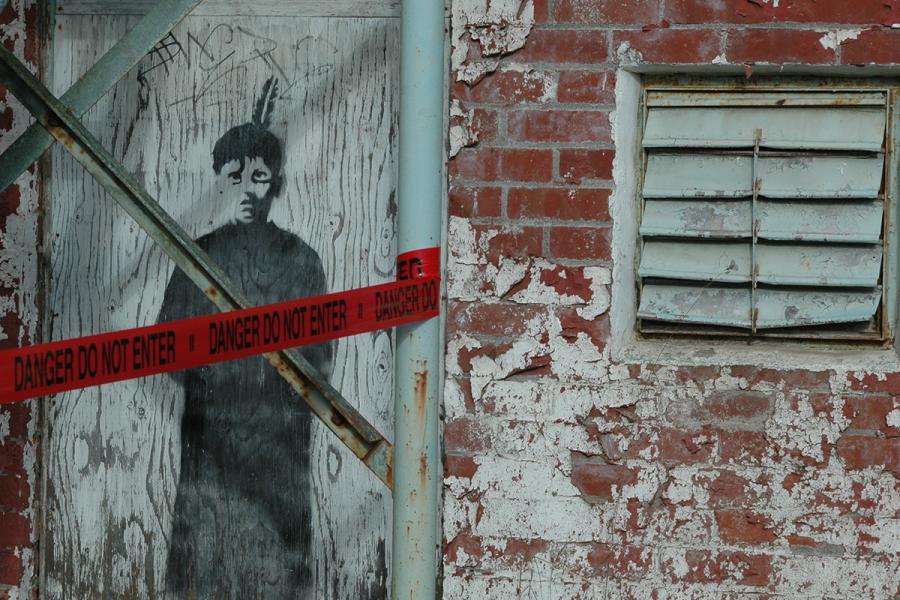Stencilled onto brick walls the colour of dried blood, images of young boys in black robes stare with ghostly eyes. One, half-hidden in a stairwell, wears an upside-down cross on his chest. Another, lurking in a corner, drips tears of blood.
The haunting figures, spray-painted onto St. Michael’s Indian Residential School in Alert Bay, B.C., are a spontaneous memorial to a dark era when thousands of Aboriginal children were removed from their homes and forced into an education system designed to assimilate them into the dominant culture.
The stencilled boys, like the students they represent, are no longer there. The former school, which the Anglican Church of Canada operated from 1929 to 1974, was demolished in March. Like so many of Canada’s former residential schools, it was a mess of asbestos, wood rot, black mould, broken windows and graffiti. And like so many former residential schools, its presence reminded survivors of their stolen culture, language and identity, their broken familial bonds and, in some cases, the physical or sexual abuse they endured.
Of the 139 former Indian residential schools in Canada, an unknown number still stand. The Assembly of First Nations is intent on finding all of them — standing or demolished — and plotting their location by GPS, before the memories are lost.
Many of the century-old buildings have been torn down. Some have become offices for First Nations; others stand but are abandoned; one (the old St. Eugene school in Cranbrook, B.C.) was renovated into a golf resort and casino owned and run by the Ktunaxa Nation; and at least a couple have been replaced with buildings that serve former students, such as the Nechi Institute, an Indigenous learning centre in St. Albert, Alta.
For many residential school survivors, demolishing these buildings is about hope for the future. But such hope, many would argue, also lies in non-Aboriginal Canadians grappling with past atrocities and the misguided intentions that led to them. Without the ominous physical presence of buildings such as St. Michael’s, will non-Aboriginal Canadians carry the weight of the memories?

One month before St. Michael’s was torn down, a ceremony to commemorate the building attracted 500 people, including dozens of survivors, as well as church leaders, both Anglican and United. Among them was United Church minister Rev. Bob Burrows. Back in the early 1960s, Burrows commuted by float plane to congregations within his multi-point charge — including Bella Coola and Alert Bay. St. Michael’s, though Anglican-run, housed many students with ties to the United churches in their home communities. These students were allowed to walk to Burrows’s church twice a month. Coincidentally, this spring Burrows took a three-month contract at Bella Coola United. He accompanied 14 survivors and 20 other adults to the February ceremony.
“When a front-end loader knocked down St. Michael’s porch, quite a few people had tears in their eyes,” says Burrows. The day of ceremonies included dancing, drumming, speeches, the Lord’s Prayer, a cleansing ceremony for survivors and a feast of locally caught crab, spot prawns, fried eulachon, salmon, roe and abalone. It also included an invitation for survivors to throw stones at the building. Several people did.
“When I talked to them [survivors] afterwards, those tears were about, ‘Okay. I’m beyond that now,’” Burrows says. “It was a brilliant idea to have that kind of a celebration that was putting away memories. It was two days of driving there and back with people in their 70s and 80s. But it was really important for them to be there.”
Namgis First Nation Chief Debra Hanuse, who represents the Aboriginal people of Alert Bay, said the school’s demolition was itself an act of reconciliation. “The generations of children who passed through the doors of the St. Michael’s residential school will not be forgotten,” she stated in her remarks before the ceremonies.
Demolishing schools, of course, means they can’t be encountered by those who never attended them. For Rev. James Scott, visiting a former residential school in 2004 “moved this history from a head experience to a heart experience.” As part of his work as the General Council’s officer for Indigenous justice and residential schools, Scott toured Mohawk Institute Residential School in Brantford, Ont., guided by survivor Geronimo Henry.
“When we got to the basement, he took us into a concrete room and stood at one of the windows, looking down a long tree-lined driveway,” says Scott. “He said that when he was in the school, he and the other children, from the middle of June on, would go into that room and stand at those tall windows to watch for their parents coming to take them home for the summer. Successively, parents would come. By the second week of July, he would realize that no one was coming for him. That story just stuck in my heart and my mind ever since. That reality. You start to realize how very sad these places were — quite apart from abuse and humiliation.”
Scott says money is available for memorials through the United Church’s Justice and Reconciliation Fund. So far, no one has applied to preserve a residential school building — but the program is open to it.
Elsewhere in the world, sites of violent injustice are retained for collective memory and repentance. For example, South Africa’s Robben Island, where Nelson Mandela spent 18 years as a prisoner, welcomes visitors. So does Auschwitz, the Nazi concentration camp, now a UNESCO World Heritage Site in Poland. Cambodia’s Tuol Sleng Genocide Museum is housed in a former Khmer Rouge execution centre. In the United States, the Carlisle Indian Industrial School in Pennsylvania has been designated a National Historic Landmark.
Not one residential school is on the list of Canada’s 950 National Historic Sites. Other memorials of residential schools are many, but scattered.
A $20-million residential schools commemoration fund, part of the 2007 class-action settlement agreement, has been spent on 143 projects — including a stained glass piece in the House of Commons commissioned to remember the 2008 Government of Canada apology. Other projects include gatherings, books and films, exhibits and memorial gardens. When the rubble is cleared at St. Michael’s, a garden and playground may replace it.
This spring, the Assembly of First Nations offered 139 markers to First Nations communities that had children taken. The original plan involved a plaque on each former school ground. However, so many of the schools are gone or in private hands that the project changed course, explains the AFN’s Kathy Kettler, who is co-ordinating the project.
“It made sense to place [the markers] in the communities, rather than in these remote locations,” says Kettler, an intergenerational survivor of the schools. “Some people don’t want to go to the place they went to residential school.”
The Aboriginal artists who were commissioned to create the markers also had a different vision than the typical historical plaque. “We collectively decided to depart from the western concept of heritage commemoration and designation,” reads the artists’ statement, “and instead create a dynamic and versatile marker as much celebrating achievements as honouring loss; significant for survivors and communities, past, present and future.” The markers are intricate bronze hoops accompanied by sticks. They’re designed to be played.
Temporary and travelling historical exhibits, web pages, school curricula and other relatively short-lived projects have emerged over the past few years. Larger in scope are the United Church’s The Children Remembered project, as well as a travelling art installation called the Witness Blanket (currently at Ottawa City Hall until July 10). In Alberta, both the Fort Normandeau Interpretive Centre and the Red Deer Museum and Art Gallery feature permanent residential school exhibits.
Burrows recalls visiting Alert Bay’s U’mista Cultural Centre with his daughter 30 years ago, built adjacent to St. Michael’s. The centre houses exhibits about the banning of the potlatch, or traditional feast, and Burrows says the displays helped his then teenage daughter realize the horror that was visited on First Nations.
Rev. Cecile Fausak, General Council’s liaison minister with residential schools, says that while exhibits can be powerful, school buildings are more complex. Some survivors see them as grim reminders of an ugly past and believe they should be torn down. Others believe they should remain as monuments to their story.
“I wouldn’t presume to enter into that discussion,” says Fausak, noting that survivors should decide how to memorialize the era. “I hope that just because the Truth and Reconciliation Commission has come to an end, that people will not think, ‘Okay, we’ve collected the stories and we don’t need to do that anymore.’ There will always be the next generations that need to know this part of our history as well. There are still many people who have not heard the stories or taken them into their heart.”
At Alert Bay, four storeys of deep red bricks, broken glass and graffiti have been erased off the shoreline.
You’d almost never know the school was there.
This story originally appeared in the June 2015 issue of The Observer with the title “Grim reminders.”















